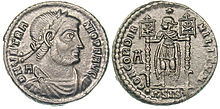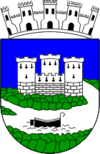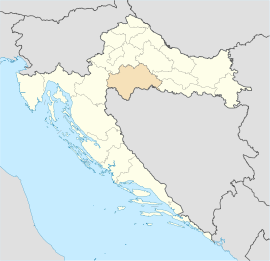Sisak
| Sisak | |||
|
|||
|
|
|||
| Basic data | |||
|---|---|---|---|
| State : |
|
||
| County : |
|
||
| Height : | 100 m. i. J. | ||
| Area : | 422.75 km² | ||
| Residents : | 47,768 (2011) | ||
| Population density : | 113 inhabitants per km² | ||
| Telephone code : | (+385) 044 | ||
| Postal code : | 44,000 | ||
| License plate : | SK | ||
| Structure and administration (status: 2013, cf. ) |
|||
| Community type : | city | ||
| Mayor : | Kristina Ikić Baniček ( SDP ) | ||
| Coalition partner : | HNS, HSU | ||
| Website : | |||
Sisak [ ˈsiːsak ] ( German historical Sissek , Hungarian Sziszek , Latin Siscia , Italian Sisek ) is a town in Croatia with about 48,000 inhabitants . The city is located at the mouth of the Kupa in the Save , which is navigable from here, and has a port. The city is home to the petroleum, iron, steel, food and chemical industries. There are also iodine sources used for medicinal purposes .
history

Sisak was called Segestia in the time of the Celts .
In Roman times, Siscia was a large and important city in the province of Pannonia with about 30,000 inhabitants. Coins minted in Siscia have been preserved from the period between 262 and 383.
The city was the seat of a Roman Catholic diocese . The first known bishop today was Quirinus of Siscia , who died a martyr's death in 309 and is venerated as a saint . Other bishops have been handed down by name up to the year 590.
In the 9th century, Sisak was the center of a principality of Pannonian Croatia ( Pannonia inferior in Latin ) under Frankish suzerainty , with the princes Ljudevit (ruled 810–823), Ratimir and Braslav (ruled 880–896).
In 901 the area was briefly conquered by the Hungarians . Then it became part of the united Croatian kingdom , which remained independent until 1102. After that it was more than 800 years in Croatia in the state union with Hungary .
On June 22, 1593, the battle of Sissek between the Habsburg monarchy and the Ottoman Empire took place here around the fortress Sisak . It was one of the first victories over the Ottomans. Sisak, in Hungarian Sziszek, was administratively part of the Kingdom of Croatia and Slavonia , in Agram County and the administrative seat of the Sziszek chair district since 1745.
During the Second World War , the vassal regime of the Independent State of Croatia established the Sisak concentration camp in Sisak , which was officially a re-education camp for children from Jewish, Serbian and Roma families, but which became practically an extermination camp due to the spread of diseases and hunger . On June 22, 1941, armed resistance against the Ustasha began in Sisak .
At the beginning of the Yugoslav War in 1991 near Glina , southwest of Sisak, the German journalist Egon Scotland was shot by Serbian paramilitaries while searching for a journalist friend in his car marked as a press vehicle . He died the same day in Sisak.
Attractions
- Former synagogue , built in 1880
- St. Quirinus Basilica , 2003
- Monument to the Troop in Brezovica Forest
Town twinning
Sisak maintains a city partnership with the following cities :
-
 Germany : Heidenheim an der Brenz , since 1988
Germany : Heidenheim an der Brenz , since 1988 -
 Bulgaria : Gabrovo
Bulgaria : Gabrovo
-
 Germany : Remchingen
Germany : Remchingen
-
 Hungary : Szombathely
Hungary : Szombathely
-
 Poland : Leszno
Poland : Leszno
-
 Czech Republic : Jihlava
Czech Republic : Jihlava
Personalities
- Menodoros († 35 BC in Siscia), also called Menas, Greek pirate
- Julian of Pannonia , Roman usurper in the 3rd century
- Quirinus of Siscia († 308 or 309), saint, bishop of Siscia in the 4th century
- Ljudevit Posavski († 823), old Croatian prince at the beginning of the 9th century
- Toma Erdődy (1558-1624), Ban
- Antun Radić (1868–1919), ethnographer and politician
- Stjepan Radić (1871–1928), politician
- Desiderius Hampel (1895–1981), SS Brigade Leader and Major General of the Waffen SS
- Veljko Maricić (1907–1973), actor
- Janko Bobetko (1919–2003), Yugoslav and Croatian general
- Ivica Horvat (1926–2012), football player
- Nenad Kralj (* 1957), specialist and university professor at the Bergische Universität Wuppertal




